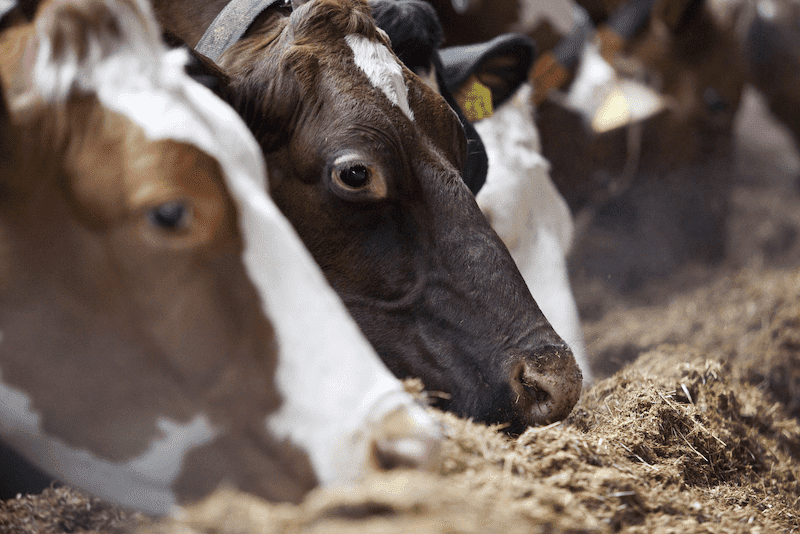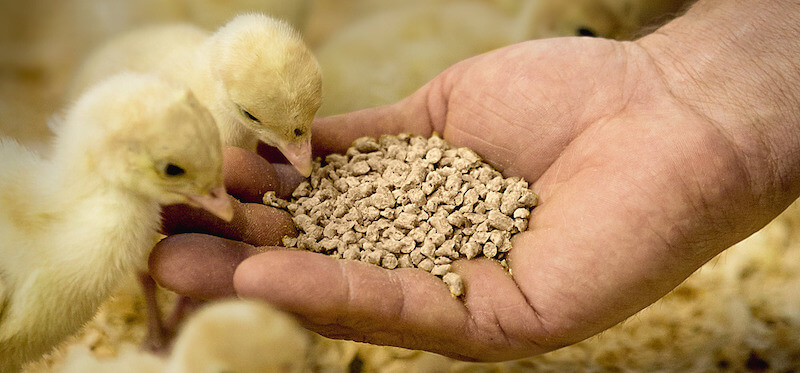
Animal feed is a crucial component of livestock production. Animal feed is composed of different ingredients like hay, grass, grain, fish, and bone meal that are essential for the growth and development of livestock, including poultry, pigs, cows, sheep, and goats.
Unfortunately, the standards for pre-mixed animal feed are minimal and manufactures often provide a product that is both inferior and ineffectual. Much of the animal feed on the market contains fillers, some of which are indigestible and do more harm than good.
Synthetic animal feed is the worst of all, providing little if any real nutritional value and causing a host of health issues that may include weakened immune systems, digestive disorders, infertility, growing fat instead of muscle and stunted growth.
Plant-based animal feed is best for livestock and there are several types. Hay is the most common and the preferred feed for horses. Due its tremendous capability to regrow a after each harvest, hay is one of the more profitable crops for animal feed producers. Silage is another common animal feed. It is made from processing an entire stalk of corn into feed. Over 20 million acres are planted with field corn each year to produce silage for the animal feed industry. Plant based animal feed also contains fillers such as alfalfa,, clover, and timothy to provide a more balanced mixture of nutrient. Last on the list are grains made from the seeds of cereal crops, like wheat, corn, and barley. Cereal crop animal feed is comparatively expensive to silage and hay and as such is available only as a high-end animal feed used to feed thoroughbred horses, for example.
Timothy is a perennial grass that is commonly used as an animal feed crop. It is a cool-season grass that is native to Europe but has been widely cultivated in North America. Timothy is valued for its high fiber and protein content, making it an excellent source of nutrition for livestock such as horses, cows, and sheep.
Timothy grass is tall and slender and can grow up to 4 feet tall in just 3 months. It has flat leaves and a spike-like seed head that blooms in the early summer. Timothy grass is a deep-rooted grass that can tolerate drought and has a moderate tolerance for cold temperatures, making it an ideal crop for regions with cooler climates.
One of the benefits of using timothy as an animal feed crop is that it is highly nutritious. The high fiber content in timothy can help improve digestion in livestock, while the protein content can help support muscle growth and development. In addition, timothy grass is relatively low in sugar, which can help prevent digestive issues in animals.
Another benefit of timothy grass is its impact on the soil and the environment. Timothy has a deep root system that can help prevent soil erosion and improve soil structure. Finally, timothy is a natural source of carbon sequestration, which can help to mitigate climate change.
Timothy grass is typically planted in the early spring and harvested in late June or early July. Timothy can regrow after being harvested, making it a sustainable crop for livestock feed production.
The process of harvesting before processing animal feed depends on the type of feed. Hay, for example, is typically cut and dried in the field before being baled and transported to storage. Silage, on the other hand, is typically harvested using a forage harvester and then fermented in a silo. Grain crops are usually harvested using a combine harvester and then dried and stored.
Wet animal feed, also known as green feed or green harvest, refers to freshly harvested plant material that is fed directly to livestock. Wet feed is used when dried hay is not available due to crop failure.

Examples of plants that can be used as wet animal feed include clover, cow corn (dent), hay, and timothy grass. These plants are typically harvested using a forage harvester, which chops the plants into small pieces for easy feeding. Due to its high moisture content, the material may be unsuitable for storage.
To preserve the nutritional value of the wet animal feed, it can be dried in the field before being stored. This involves spreading the freshly harvested plant material out over the ground so it can dry in the sun. When the material attains a moisture content of between 15-20%, it is then ready to be baled and stored.
Alternatively, wet animal feed can be fed directly to livestock without drying. Dumping the feed into a feed trough or spreading it out on the ground will suffice. However, care must be taken to prevent spoilage, as the high moisture content can cause the feed to rot or ferment if not consumed quickly.
Dry animal feed is made by mixing a combination of hay, silage, and grain together. This mixture is then processed into pellets or cubes for easy packaging, shipping, and feeding. The process of making dry animal feed involves several steps, which are outlined below.
Ingredient Selection: The first step in making dry animal feed is to select the appropriate ingredients. This will depend on the nutritional needs of the animals being fed, their age and weight. Dry feed ingredients may include alfalfa, clover, timothy grass, corn, soybeans, and wheat.
Grinding and Mixing: Once feed ingredients have been selected, they are ground and mixed in a large mixer. The mixing process combines the ingredients evenly so that each animal receives a digestible balance of nutrient.
Conditioning: After the ingredients have been mixed, the feed is conditioned to improve its texture and moisture content. Adding steam to the mixture helps to soften the ingredients making them more pliable.
Pelleting or Cubing: After the ingredients have been mixed, the feed is conditioned to improve its texture and moisture content. Adding steam to the mixture helps to soften the ingredients making them more pliable.
Quality Control: Throughout the process of making dry animal feed, quality control measures are put in place to ensure that the feed meets certain standards. This may include testing the feed for nutritional content, moisture content, and other factors.
Throughout the process of making dry animal feed, quality control measures are put in place to ensure that the feed meets certain standards. This may include testing the feed for nutritional content, moisture content, and other factors.
Cows, sheep, goats, pigs, and poultry all require a certain type of animal feed, which is determined the animal's age, size, and purpose. A lactating cow will require more feed than a young calf, for example.
Animal feed can be distributed to livestock in feeding troughs or on top of open fields.
Free range feeding involves allowing beef cattle, sheep, and goats to graze and forage freely in a pasture or range. In a free-range system, animals may be supplemented with hay or other forms of feed during periods of low pasture availability.
Pen feeding involves confining poultry and pigs, as well as some beef and dairy cattle to a specific area or pen and providing them with a regular supply of feed. In a pen feeding system, animals may be fed a mixture of hay, silage, and grain, either in a dry or wet form.
Factory farming, also known as intensive livestock farming, contains large numbers of animals in a confined space. This system is commonly used for poultry, pigs, and dairy cattle. Sometimes referred to as a “prison for animals”, animals fed a specialized diet that is intended to fatten them up as quickly as possible for processing.
Free range systems are often favored by consumers who are concerned about animal welfare and environmental sustainability, while pen and factory farming systems may be favored by producers looking to maximize efficiency and profitability.

Natural animal feed, such as hay and pasture, provides several benefits to livestock. First and foremost, it is a rich source of nutrients that include protein, fiber, and minerals. Secondly, it is more cost-effective than chemical-based artificial animal feed and finally, it is more sustainable and environmentally friendly than chemical-based feed.
In practice, animal feed is used to supplement an animal's diet during the winter months, when grass and other plants are scarce. Similarly, during periods of high growth or lactation, animals may require additional feed to support their increased nutrient needs.
Chemical-based artificial animal feed is made from by combining synthetic nutrients and additives. Common types of chemical-based feed include pelleted feed, which is made by compressing and heating a mixture of grains and other ingredients together, and textured feed, which is made by adding molasses or other flavorings to the feed.
While chemical-based artificial animal feed can be a convenient and cost-effective way to feed livestock, chemical-based feed can contain harmful chemicals and additives that can be harmful to the health of the animals that consume it.
Secondly, the production of animal feed can have a negative impact on the environment. The use of chemical-based fertilizers and pesticides to grow the crops used in animal feed can pollute water, degrade soil, and reduce biodiversity.
Animal feed is a critical component of livestock production, and the type of feed used can have a significant impact on the health of the animals and the environment. Chemically produced animal feed may be convenient and cost-effective however, producers should explore natural alternatives whenever possible.
Ready to transform your land into a high-yield, sustainable farm? Let Crop Circle Farms design and build a custom, low-impact, and water-efficient farm tailored to your needs. Double your income and cut your costs in half! Contact Us
Help us expand our mission to revolutionize agriculture globally. We are seeking partners to implement Crop Circle Farms to feed people in need. Together, we can build scalable food production systems that save water, reduce costs, and feed thousands of people. Contact Growing To Give